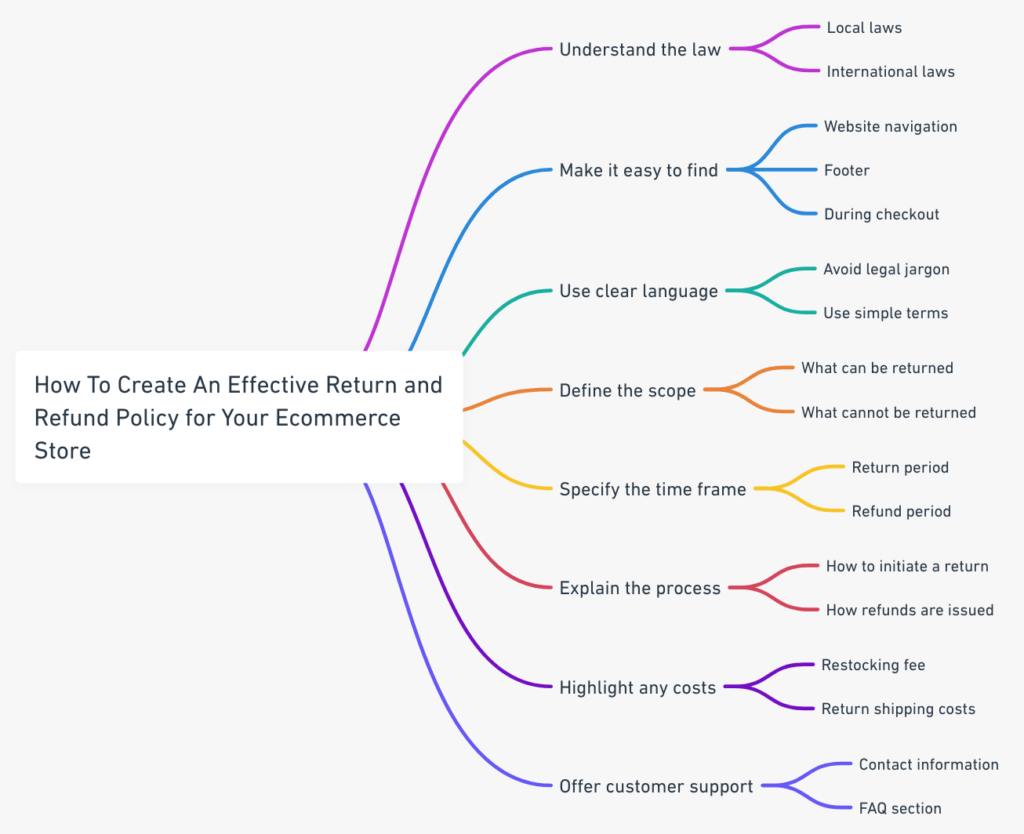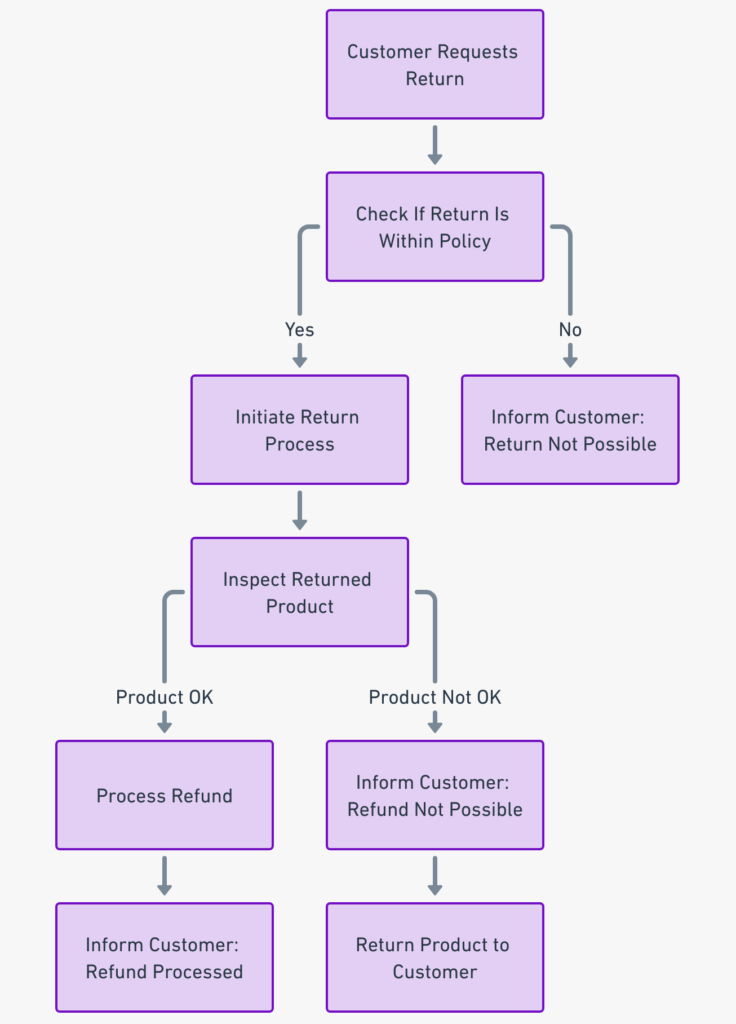Many businesses overlook the Return and Refund Policy, which significantly influences customer satisfaction and loyalty. Owners consider this aspect a minor detail, burden, or potential loss.
They don’t realize the serious repercussions of a poorly crafted or non-transparent return policy can result in lost sales, negative reviews, and a damaged reputation.
Picture this: a customer, excited about their purchase from your store, receives their package only to find that it’s not what they expected. They turn to your return and refund policy for reassurance but are met with confusing jargon, hidden conditions, or no policy.
Now they feel deceived, frustrated, and far less likely to trust your business in the future. They vent their dissatisfaction on review platforms, and like a line of falling dominos, potential customers begin to doubt your credibility.
The good news? This damaging scenario is entirely preventable. With a clear, fair, and effective return and refund policy, you can convert potential loss into an opportunity for increased trust and loyalty while fostering a better relationship with your customers. And it’s not as daunting as it might sound.
This guide will walk you through creating an effective return and refund policy for your ecommerce store, ensuring your peace of mind and customer satisfaction.
Let’s dive in!
Table of Contents
Key Takeaways
- A clear and fair return policy leads to more sales and higher customer satisfaction.
- Utilizing technology solutions can make the return process more efficient.
- Offering free return shipping removes obstacles to returning items.
- Continuous evaluation and refinement of the return policy are essential for customer satisfaction and business growth.

Understand the Importance of an Ecommerce Return and Refund Policy
An ecommerce return and refund policy is crucial to running an online store. It outlines the terms and conditions for customers to return or exchange products and receive refunds.
A well-crafted return and refund policy can significantly impact your business’s reputation, customer satisfaction, and overall success. Here are some reasons why having a clear and comprehensive return and refund policy is essential for your ecommerce store:
1. Builds Trust and Confidence
A transparent and fair return and refund policy demonstrates that your business values its customers and stands behind the quality of its products. This helps build trust and confidence among potential buyers, making them more likely to complete a purchase.
2. Reduces Customer Confusion
A clear return and refund policy helps customers understand the process and requirements for returning or exchanging products. This reduces confusion and potential disputes, leading to a smoother shopping experience for the customer and the business.
3. Enhances Customer Satisfaction
Providing a smooth return and refund procedure can greatly enhance customer satisfaction. When customers are aware that they can effortlessly return or exchange a product if it fails to meet their expectations, they are more inclined to feel content with their entire shopping experience.
4. Encourages Repeat Business
Customers with a positive experience with your return and refund policy are likelier to become loyal, repeat customers. By making the return process easy and convenient, you can encourage customers to continue shopping with your store in the future.
5. Complies with Legal Requirements
In many jurisdictions, businesses are legally required to have a return and refund policy in place. Ensuring your policy complies with applicable laws and regulations can help avoid potential legal issues and penalties.
6. Reduces Chargebacks and Fraud
A well-defined return and refund policy can help reduce the likelihood of chargebacks and fraud. By clearly outlining the conditions under which returns and refunds are accepted, you can minimize the chances of customers initiating chargebacks or attempting to exploit your policy.
Return and Refund Policy Template:
Here is a basic template for a return and refund policy. Please note that it’s recommended to review this with a legal advisor to make sure it complies with local laws and regulations and that it suits your specific business needs:
[Your Company Name] Return and Refund Policy
Thank you for shopping at [Your Company Name]. We want to ensure you have a rewarding experience while exploring, evaluating, and purchasing our products. As with any shopping experience, some terms and conditions apply to transactions. We’ll be as brief as our attorneys will allow.
Returns
If you are unsatisfied with your purchase, we’re here to help.
You have [number of calendar days to return an item from the date you received it].
To be eligible for a return, your item must be unused and in the same condition you received it. It must also be in the original packaging.
Please do not send your purchase back to the manufacturer.
Refunds
Once we receive your item, we will inspect it and notify you that we have received your returned item. We will immediately notify you of the status of your refund after inspecting the item.
Upon approving your return, we’ll promptly initiate a refund to your original payment method. The time it takes for the refunded amount to reflect in your account largely depends on your card issuer’s policies.
Typically, it’s a matter of a few days until you’ll see the credit back in your account. Please keep an eye on your account balance, or feel free to contact your card issuer for any specific queries about the timeline.
Shipping
You will be responsible for paying for your shipping costs for returning your item. Shipping costs are non-refundable. If you receive a refund, the cost of return shipping will be deducted from your refund.
Contact Us
If you have any questions on how to return your item to us, contact us at [contact email/phone number].
Free Policy Generator Tools
Here are some free policy generator tools that can help you create a Refund Policy, Privacy Policy, Terms of Service, and Shipping Policy for your online store:
1. Shopify Policy Generator
Shopify offers a free policy generator tool for creating essential policies for your online store. You don’t need to be a Shopify user to access this tool. It can generate the following policies:
- Refund Policy
- Privacy Policy
- Terms of Service
To use the Shopify Policy Generator, visit the following link: Shopify Policy Generator
2. TermsFeed
TermsFeed is another popular policy generator tool that offers free policy templates for various types of policies, including:
- Privacy Policy
- Terms of Service
- Refund Policy
To use TermsFeed, visit the following link: TermsFeed Policy Generator
3. GetTerms
GetTerms is a simple and easy-to-use policy generator tool that can create custom policies for your online store, including:
- Privacy Policy
- Terms of Service
To use GetTerms, visit the following link: GetTerms Policy Generator
4. PrivacyPolicies.com
PrivacyPolicies.com offers a free policy generator tool that can create various policies for your online store, such as:
- Privacy Policy
- Terms of Service
- Refund Policy
To use PrivacyPolicies.com, visit the following link: PrivacyPolicies.com Policy Generator
5. FreePrivacyPolicy
FreePrivacyPolicy is another policy generator tool that can create a custom Privacy Policy for your online store. Although it primarily focuses on Privacy Policies, it also offers a Terms of Service generator. To use FreePrivacyPolicy, visit the following link: FreePrivacyPolicy Generator.
Remember to review and customize the generated policies to ensure they accurately represent your business practices and comply with any applicable laws and regulations.
Define Your Return Window
To establish a clear and efficient framework for handling returns, it is crucial to determine the specific period during which customers can initiate return requests. This defined timeframe is known as the return window.
Setting return deadlines requires careful consideration of various factors such as customer satisfaction, operational efficiency, and cost management.

Return window flexibility is essential in giving customers the freedom to return products without feeling rushed or constrained. E-commerce businesses can enhance customer experience and build trust by offering a reasonable return timeframe.
However, it is equally important to balance flexibility and practicality. A longer return window may increase costs due to extended inventory holding periods and potential product depreciation.
To illustrate this concept further, consider the following table:
| Return Window | Customer Satisfaction | Operational Efficiency |
|---|---|---|
| 30 days | High | Moderate |
| 60 days | Very high | Low |
As shown in the table above, extending the return window to 60 days increases customer satisfaction but may negatively impact operational efficiency.
Defining your return window requires careful analysis of customer expectations and operational capabilities. Finding a balance that maximizes customer satisfaction and operational efficiency is necessary while considering the financial implications of prolonged product returns.
Communicate Your Policy to Customers
Communicating the policy regarding product returns is essential for fostering a sense of trust and satisfaction among customers, ensuring that they are well informed about the process and can make informed decisions regarding their purchases.
When implementing any changes to the return policy, it is crucial to communicate these modifications to customers transparently.
This can be achieved through various channels, such as website banners, email newsletters, or social media announcements.
Customers will feel valued and respected by clearly stating the updated policy and explaining the reasons behind the changes.
Additionally, it is important to handle customer inquiries promptly and efficiently. Providing multiple avenues for customers to reach out with their questions or concerns, such as phone support or live chat services, enables them to obtain quick responses.
Training customer service representatives on the return policy are equally vital to provide accurate information and assist customers effectively.
Furthermore, e-commerce businesses should consider creating an easily accessible FAQ section on their website that addresses common inquiries related to returns.
This resource will empower customers by providing them with self-help options while reducing the volume of repetitive queries received by customer service teams.
Clear communication of an e-commerce return policy is crucial for building customer trust and ensuring satisfaction. Effectively communicating policy changes and efficiently handling customer inquiries are key components in achieving this goal.
Provide Easy and Convenient Return Options
Providing seamless and user-friendly return options for online shoppers is essential to fostering customer satisfaction and building trust. Convenient return options ensure hassle-free returns, ultimately contributing to a positive shopping experience.
To achieve this, e-commerce businesses can implement the following strategies:
- Prepaid Return Labels: Offering prepaid return labels simplifies the return process for customers as it eliminates the need to pay for return shipping. This convenience reduces friction and encourages more customers to make returns if necessary.
- Multiple Return Options: Providing multiple return options lets customers choose their preferred return method. Whether dropping off at a local store or shipping it back, offering flexibility ensures convenience.
- Streamlined Online Returns Portal: Creating an intuitive online returns portal allows customers to initiate their returns quickly with just a few clicks. The portal should have clear instructions and step-by-step guidance throughout the process, reducing frustration and saving time.
- Automated Refunds: Implementing automated refund processes ensures customers receive their money back promptly after initiating a return request. This enhances convenience and builds trust by demonstrating reliability and efficiency.
This way, e-commerce businesses prioritize customer satisfaction while establishing themselves as reliable and trustworthy brands within the competitive online marketplace.
Offer Free Return Shipping (if feasible)
Offering free return shipping, if feasible, can be a strategic approach to incentivize online shoppers by reducing the financial burden associated with returning items and visually portraying a commitment to customer satisfaction. Return shipping cost is one of the major concerns for customers when deciding whether or not to make an online purchase.
E-commerce businesses can eliminate this barrier by offering free return shipping and encourage hesitant customers to complete their purchases. Create a return policy considering free returns or exchanges.
In addition to reducing the financial burden on customers, free return shipping also enhances the efficiency of the return process. When customers are responsible for return shipping costs, they may hesitate or delay initiating returns, resulting in longer processing times and potential dissatisfaction.
However, by providing free return shipping, businesses can streamline the process and ensure that returns are initiated promptly. This leads to improved customer experience and higher levels of satisfaction.
To further illustrate the benefits of offering free return shipping, consider the following:
| Benefits of Offering Free Return Shipping |
|---|
| Reduces financial burden on customers |
| Encourages hesitant customers |
| Enhances efficiency of return process |
| Improves customer experience |

By incorporating these strategies into their e-commerce return policy, businesses can create a more effective system that reduces customer barriers while ensuring efficient returns.
Establish Clear Guidelines for Product Condition
Establishing clear guidelines for product conditions is essential to ensure a standardized and transparent process for handling returns and exchanges. By clearly defining what constitutes an acceptable condition for returned items, e-commerce businesses can effectively manage return expectations and minimize customer disputes.
To establish product eligibility, e-commerce retailers should consider the following guidelines:
- Clearly state the criteria for acceptable product condition, such as unopened packaging, undamaged items, and intact labels.
- Provide detailed descriptions or images of any potential defects or damages that may affect a product’s eligibility for return.
- Specify any exceptions or limitations on returns based on specific product categories, such as perishable goods or personalized items.
After implementing these guidelines, e-commerce businesses can ensure customers clearly understand what is expected when returning products. This transparency reduces confusion and helps protect the business from fraudulent returns.
Furthermore, managing return expectations involves setting realistic timelines for returning products and providing clear instructions on initiating a return. By clearly communicating these details upfront, e-commerce businesses can streamline the return process and enhance customer satisfaction.
Establishing clear guidelines for product conditions is crucial in creating an effective e-commerce return policy. It enables businesses to manage return expectations efficiently while maintaining transparency with customers.
Streamline the Return Process
Streamlining the return process is essential for ensuring a seamless and efficient experience for customers, thereby enhancing their satisfaction with the e-commerce platform.
To improve efficiency, e-commerce platforms should implement clear and concise return policies that outline specific steps customers must follow when returning a product. This includes detailed instructions on how to package the item and where to ship it back.
Additionally, integrating an online portal or automated system can streamline the entire return process by allowing customers to initiate returns online, track their progress, and receive updates on refunds or exchanges.
Furthermore, establishing effective communication channels is crucial in streamlining the return process. E-commerce businesses should offer various customer support options such as live chat, email, or phone assistance dedicated specifically to handling returns. Promptly addressing customer inquiries regarding returns helps prevent unnecessary delays or frustrations.
E-commerce businesses can improve operational efficiency and customer satisfaction by streamlining the return process. A simplified and efficient return experience saves time for both parties involved and builds customer trust and loyalty. Ultimately, this can lead to greater customer retention rates and increased sales for e-commerce platforms.
Consider Offering Store Credit or Exchanges
Consideration could be given to providing customers with store credit or exchanges, allowing them to choose an alternative product that better meets their needs and preferences. Offering store credit benefits both the customer and the e-commerce business.
It provides customers with flexibility and freedom in selecting a different item from the online store without losing money. They can use the store credit towards another purchase, which increases customer satisfaction and loyalty.
Offering exchanges allow customers to replace a defective or unsatisfactory product with one that meets their expectations. This helps build trust between the customer and the business, as it shows a commitment to ensuring customer satisfaction.
To streamline the exchange process, several steps can be implemented:
- Communicate the exchange policy: Provide detailed information about how exchanges work, including any requirements or limitations.
- Simplify return shipping: Offer prepaid return labels or arrange for pickups to make returning products more convenient for customers.
- Efficient inventory management: Ensure replacement products are readily available in stock to minimize delays in processing exchanges.
By considering these factors and incorporating store credit or exchange options into your e-commerce return and refund policies, you can provide customers a hassle-free experience while benefiting your business through increased customer satisfaction and loyalty.
Monitor and Analyze Return Data
Monitoring and analyzing return data allows businesses to gain valuable insights into customer behaviour and preferences, enabling them to make data-driven decisions to enhance the overall customer experience and drive business growth.
Analyzing customer feedback is crucial in understanding the reasons behind returns. By examining customer comments, suggestions, and complaints, businesses can identify common issues or pain points that lead to returns.
This information can then be used to address these concerns proactively, whether through improving product descriptions or enhancing the quality of products.
Furthermore, tracking return trends gives businesses a comprehensive view of their performance in handling returns. It allows them to identify which products have higher return rates and understand why customers are dissatisfied with those particular items.
With this knowledge, businesses can take appropriate actions, such as adjusting product specifications or addressing quality control issues.
Monitoring and analyzing return data is vital in optimizing an e-commerce return policy. It helps businesses understand their customers better by providing valuable insights into their preferences and pain points.
Continuously Update and Improve Your Return Policy
To continually enhance customer satisfaction and adapt to changing market dynamics, it is imperative for businesses to consistently evaluate and refine their approach towards handling product returns.
Continuous improvement of the return policy is essential for e-commerce companies as it allows them to address any potential customer issues or concerns and make necessary adjustments. One effective way to achieve this is by actively seeking and incorporating customer feedback into the policy.
Customer feedback is crucial in identifying areas requiring improvement in the return process. By analyzing feedback, businesses can gain valuable insights into common reasons for returns, such as product quality issues or difficulties with the return procedure. This information enables companies to implement targeted changes that directly address these concerns, ultimately increasing customer satisfaction and loyalty.

To visually represent this concept, a table can be utilized to showcase the continuous improvement cycle of an e-commerce return policy:
| Stage | Actions | Outcome |
|---|---|---|
| Evaluation | Analyze returns | Identify trends |
| Improvement | Implement changes | Address concerns |
| Assessment | Monitor results | Measure impact |
By following this iterative process of evaluation, improvement, and assessment based on customer feedback, businesses can create an effective e-commerce return policy that meets customer expectations and drives positive business outcomes.
Frequently Asked Questions
Can customers return products after the defined return window?
Customers should not be allowed to return products after the defined return window. This is to ensure that customers have a good shopping experience and that the return policy for your ecommerce store is effective. Allowing returns outside the set time frame can cause extra costs, logistical problems and may be abused.
By creating a clear and strict return window, e-commerce businesses can ensure customers get timely refunds or exchanges while protecting themselves. This approach ensures everyone is clear on the rules and helps customers have a positive shopping experience.
What happens if a customer returns a product in a damaged condition?
When a customer sends back a product that has been damaged, the e-commerce company should have a policy in place for how to handle it. This policy should explain what needs to happen to deal with the issue and give the customer the appropriate compensation.
This might involve figuring out how bad the damage is, who is at fault, and what solutions are available, such as repairs, replacements, or refunds. It is important to handle the situation quickly and fairly so customers are satisfied and continue to do business with the e-commerce company.
Are there any restrictions on returning certain types of products?
Certain types of products may have restrictions when it comes to returns. The rules for returning products depend on the e-commerce platform or retailer. Perishable items, like food, often can’t be returned because they can spoil. Before buying perishable items, be sure to check the return policy. This way, you’ll know if you can get a refund if you’re unhappy with your purchase.
How long do customers receive their refund or store credit take?
Getting your refund or store credit can be a confusing process. That’s why it’s important to have clear guidelines for how long the process should take. Having an expected timeline helps customers know what to expect and builds trust. Good communication is also key. Letting customers know what’s happening with their refund or store credit helps reduce frustration and make the experience more enjoyable.
What should customers do if they receive a wrong or defective product?
If you receive a wrong or defective product, there are a few steps you should take. First, ask the e-commerce platform for a return authorization. You can usually do this by logging into your account or contacting customer support. Documenting the product’s condition with pictures or descriptions is important before returning it. This will help ensure your issue is communicated and noted so the problem can be fixed quickly.
Conclusion
A good e-commerce return and refund policy is important for a successful online store. Knowing why having a return policy is important, setting a clear period for when customers can return items, and explaining the policy to customers in an easy-to-understand way will ensure customers are happy.
It’s also good to offer free shipping for returns when possible and look into giving store credit or exchanges instead of refunds. Finally, pay close attention to how the policy works and make changes when needed for a better customer experience.







